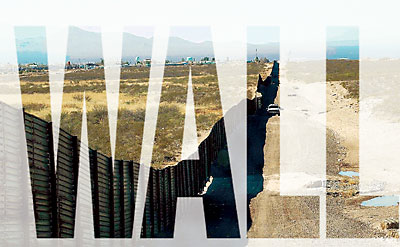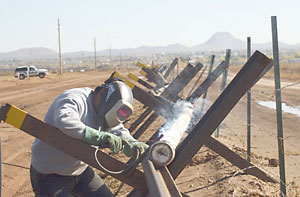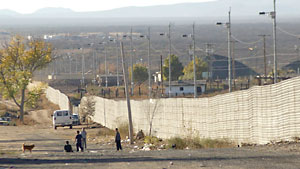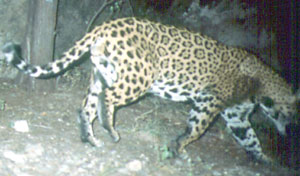

LUKE TURF
Tucson Citizen
July 1, 2003
 After protests locally and nationally,
officials from the Department of Homeland Security say a controversial
proposal to barricade most of the border between Arizona and Mexico is
"not based upon reality."
After protests locally and nationally,
officials from the Department of Homeland Security say a controversial
proposal to barricade most of the border between Arizona and Mexico is
"not based upon reality."
 The proposal, which cost about $250,000,
is known as the Border Patrol's Draft Programmatic Environmental Impact
Statement, and it's going back to the drawing board.
The proposal, which cost about $250,000,
is known as the Border Patrol's Draft Programmatic Environmental Impact
Statement, and it's going back to the drawing board.
 Originally released in October 2002,
the 354-page statement was supposed to envision all the roads, lights,
fences and other development the agency would need to effectively secure
the border. It's part of the National Environmental Policy Act requiring
agencies to assess impacts of broad governmental policies.
Originally released in October 2002,
the 354-page statement was supposed to envision all the roads, lights,
fences and other development the agency would need to effectively secure
the border. It's part of the National Environmental Policy Act requiring
agencies to assess impacts of broad governmental policies.
 But according to Jim Caffrey, facilities
director for the Border Patrol, the agency got "a little carried away"
and envisioned more infrastructure than could ever be needed, even if the
United States and Mexico went to war, he said.
But according to Jim Caffrey, facilities
director for the Border Patrol, the agency got "a little carried away"
and envisioned more infrastructure than could ever be needed, even if the
United States and Mexico went to war, he said.
 "We're going to go back and be, I
guess, a little bit more realistic," he said. "We were a little bit overly
enthusiastic when we started this process."
"We're going to go back and be, I
guess, a little bit more realistic," he said. "We were a little bit overly
enthusiastic when we started this process."
 Nonetheless, the proposal created
a united front of human rights and environmental organizations joining
forces to "bring down the wall."
Nonetheless, the proposal created
a united front of human rights and environmental organizations joining
forces to "bring down the wall."
 The Department of Homeland Security
got 162 comment letters and about 1,000 unsigned form letters regarding
the project, according to the department's program manager for border infrastructure,
Geraldine Pontius.
The Department of Homeland Security
got 162 comment letters and about 1,000 unsigned form letters regarding
the project, according to the department's program manager for border infrastructure,
Geraldine Pontius.

A monument to migrants who have tried to cross into the United States stands on the Mexican side of the border near Agua Prieta in May 2002.
 Of the 351 miles of land border between
Arizona and Mexico, 261 miles fall within the Border Patrol's Tucson sector.
The agency proposed to line 222.3 of the 261 miles with a primary pedestrian
barrier, on top of what already exists. In addition, the statement called
for 233 miles of secondary barriers with a road in between the two fences
to make it twice as hard for people to illegally enter the United States.
Of the 351 miles of land border between
Arizona and Mexico, 261 miles fall within the Border Patrol's Tucson sector.
The agency proposed to line 222.3 of the 261 miles with a primary pedestrian
barrier, on top of what already exists. In addition, the statement called
for 233 miles of secondary barriers with a road in between the two fences
to make it twice as hard for people to illegally enter the United States.
 It also called for 631 miles of new
roads in the Tucson sector and dozens of lights, including stadium-style
fixtures.
It also called for 631 miles of new
roads in the Tucson sector and dozens of lights, including stadium-style
fixtures.
 "Many of these ideas were not based
upon reality and were only conjectured plans for a USBP response to a 'worst
case scenario,' " according to a public notice issued by the Department
of Homeland Security.
"Many of these ideas were not based
upon reality and were only conjectured plans for a USBP response to a 'worst
case scenario,' " according to a public notice issued by the Department
of Homeland Security.
 The original statement concluded the
plan to move ahead with the barriers, roads and lights would have "no significant
impact" on the environment.
The original statement concluded the
plan to move ahead with the barriers, roads and lights would have "no significant
impact" on the environment.
 And it was "a joke in terms of its
analysis," according to Scotty Johnson, Defenders of Wildlife's rural outreach
coordinator in Tucson.
And it was "a joke in terms of its
analysis," according to Scotty Johnson, Defenders of Wildlife's rural outreach
coordinator in Tucson.
 "This is either total incompetence
or an attempt to slip it through without scrutiny," Johnson said of the
statement. "It was so poorly done it was offensive to science (and) it
was offensive to policy-makers who need to decide the impacts of the development."
"This is either total incompetence
or an attempt to slip it through without scrutiny," Johnson said of the
statement. "It was so poorly done it was offensive to science (and) it
was offensive to policy-makers who need to decide the impacts of the development."
 It's particularly disturbing to Johnson
because the proposed barriers won't only keep out illegal immigrants, but
they'll also prevent the return of a sometimes-spotted, sometimes-black
jaguar that once called Arizona home. Populations are now found only in
Mexico. Johnson says the jaguar was sighted in Arizona recently, hinting
at a possible migration from Mexico, but the walls would stop any progress
in the species return.
It's particularly disturbing to Johnson
because the proposed barriers won't only keep out illegal immigrants, but
they'll also prevent the return of a sometimes-spotted, sometimes-black
jaguar that once called Arizona home. Populations are now found only in
Mexico. Johnson says the jaguar was sighted in Arizona recently, hinting
at a possible migration from Mexico, but the walls would stop any progress
in the species return.
 The statement also didn't take into
consideration the effect of 24 hours of light, 365 days a year, on nocturnal
animals such as the endangered lesser long-nosed bat, Johnson said.
The statement also didn't take into
consideration the effect of 24 hours of light, 365 days a year, on nocturnal
animals such as the endangered lesser long-nosed bat, Johnson said.

The U.S.-Mexico border fence just outside Douglas is repaired in May 2002 after someone tried to drive through it.
 It also ignores the endangered pygmy
owl, said Daniel Patterson of the Center for Biological Diversity.
It also ignores the endangered pygmy
owl, said Daniel Patterson of the Center for Biological Diversity.
 "It's going to trap wildlife on both
sides of the border," Patterson said of the barriers. "The wall would take
what is currently a political barrier and make it a wildlife barrier."
"It's going to trap wildlife on both
sides of the border," Patterson said of the barriers. "The wall would take
what is currently a political barrier and make it a wildlife barrier."
 Besides the biological impact, human
rights groups such as Tucson-based Derechos Humanos, spearheads of the
Bring Down the Walls campaign, are concerned about the political impact
and the impact on people who illegally immigrate to the United States,
because it would push them even farther into the harsh deserts where more
than 50 people have already died since October.
Besides the biological impact, human
rights groups such as Tucson-based Derechos Humanos, spearheads of the
Bring Down the Walls campaign, are concerned about the political impact
and the impact on people who illegally immigrate to the United States,
because it would push them even farther into the harsh deserts where more
than 50 people have already died since October.
 "With the history and experience of
this strategy of sealing the border, policy-makers should be charged with
high crimes in an international tribune," said Derechos Humanos founder
Isabel Garcia. "It's outrageous that we are creating a war zone between
the states of Arizona and Sonora."
"With the history and experience of
this strategy of sealing the border, policy-makers should be charged with
high crimes in an international tribune," said Derechos Humanos founder
Isabel Garcia. "It's outrageous that we are creating a war zone between
the states of Arizona and Sonora."
 Garcia said 15 to 20 local organizations
have signed on to Bring Down the Walls.
Garcia said 15 to 20 local organizations
have signed on to Bring Down the Walls.
 Pontius said the agency plans to "rewrite"
the statement.
Pontius said the agency plans to "rewrite"
the statement.
 "Needs that were identified two or
three years ago can change," Pontius said. "I don't know if it's less or
more. We don't know what it is; we haven't determined it yet."
"Needs that were identified two or
three years ago can change," Pontius said. "I don't know if it's less or
more. We don't know what it is; we haven't determined it yet."
 But Johnson, who said his agency never
received a copy of the statement despite requesting it, said he doubts
the agency will do more than pay lip service to environmental laws.
But Johnson, who said his agency never
received a copy of the statement despite requesting it, said he doubts
the agency will do more than pay lip service to environmental laws.
 "Is this or is this not developments
into the foreseeable future?" Johnson asked. "It may be that their philosophy
is it's better to beg forgiveness than ask permission, but once the wall
is up, the wall is up."
"Is this or is this not developments
into the foreseeable future?" Johnson asked. "It may be that their philosophy
is it's better to beg forgiveness than ask permission, but once the wall
is up, the wall is up."

Light poles tower over children playing on the Mexico side of the border. Environmentalists say that a proposal to keep lights on 24 hours a day would hurt nocturnal animals, such as an endangered type of bat.
 Caffrey and Pontius insisted the statement
doesn't give the agency a green light for any construction. They said they
hope to have a new issue out for review by the end of the year.
Caffrey and Pontius insisted the statement
doesn't give the agency a green light for any construction. They said they
hope to have a new issue out for review by the end of the year.
 Any project to be implemented by the
Border Patrol must include a published environmental assessment, for which
the statement acts as a reference, that must be reviewed by agencies including
the U.S. Fish & Wildlife Service, they said.
Any project to be implemented by the
Border Patrol must include a published environmental assessment, for which
the statement acts as a reference, that must be reviewed by agencies including
the U.S. Fish & Wildlife Service, they said.
 Of the Border Patrol's four types
of fencing, the document doesn't specify which types would have been used,
which further irked Sean Garcia, senior associate of the Washington- based
Latin America Working Group, a national coalition focused on the impact
of U.S. policy on Latin American human rights.
Of the Border Patrol's four types
of fencing, the document doesn't specify which types would have been used,
which further irked Sean Garcia, senior associate of the Washington- based
Latin America Working Group, a national coalition focused on the impact
of U.S. policy on Latin American human rights.
 "They say they can't find any kind
of environmental impact, and they don't even know what kind of fencing
they are going to use," he said.
"They say they can't find any kind
of environmental impact, and they don't even know what kind of fencing
they are going to use," he said.
 Even the U.S. Environmental Protection
Agency expressed objections to the statement.
Even the U.S. Environmental Protection
Agency expressed objections to the statement.
 "The DPEIS lacks critical information
regarding the proposed actions and their environmental impacts. The infrastructure
proposed in the preferred alternative will result in the alteration of
5,260 acres of land which will be stripped of vegetation, graded, filled,
or paved.
"The DPEIS lacks critical information
regarding the proposed actions and their environmental impacts. The infrastructure
proposed in the preferred alternative will result in the alteration of
5,260 acres of land which will be stripped of vegetation, graded, filled,
or paved.
 "An additional 1,700 acres of land
will be disturbed by proposed operations, including continued patrol activities
and illumination for 12-hour periods at night with stadium-style lighting.
The affected area includes critical habitat for over 43 endangered species,
numerous streams, wetlands, and ephemeral washes, unknown number of cultural
and native American sites, including reservation property of 10 Indian
tribes, and 27 ecologically unique sites," according to a letter issued
by the agency.
"An additional 1,700 acres of land
will be disturbed by proposed operations, including continued patrol activities
and illumination for 12-hour periods at night with stadium-style lighting.
The affected area includes critical habitat for over 43 endangered species,
numerous streams, wetlands, and ephemeral washes, unknown number of cultural
and native American sites, including reservation property of 10 Indian
tribes, and 27 ecologically unique sites," according to a letter issued
by the agency.

A jaguar was captured on film by the Arizona Game & Fish Department.